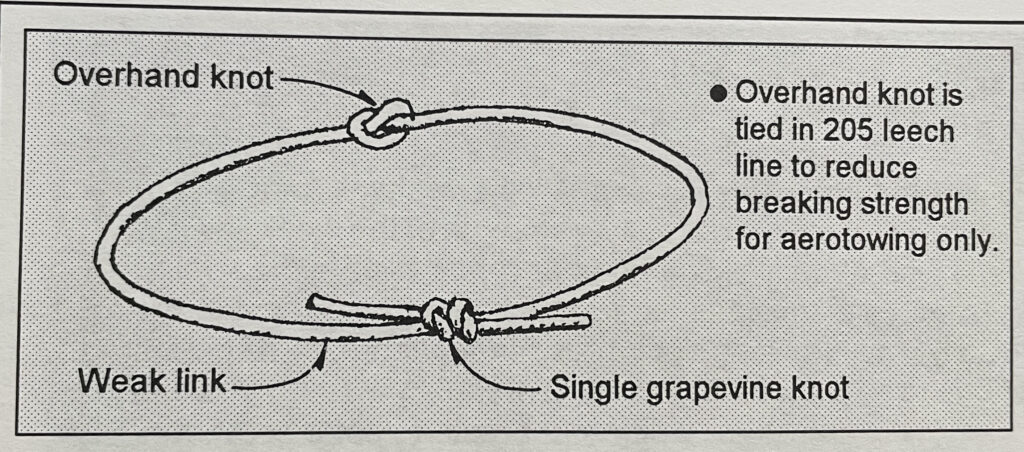WEAK LINKS
A weak link is a very simple device—typically a loop of line—that is intended to break in the event towline tensions exceed a safe or desired threshold. Weak links have greatly improved the safety of towing over the years. Unfortunately, there is a significant amount of misunderstanding and inaccurate information about what a weak link can and cannot provide for the pilot’s safety.
WEAK LINKS AND LOCKOUTS
A common belief is that a weak link will protect a pilot from lockouts, high bank turns high angles of attack and other such perils. This belief is predicated on the notion that these maneuvers cause increases in tow force which breaks the weak link and frees the pilot from the towline.
The validity of this argument is entirely dependent upon the kind of towing that is being performed. We can list two general categories of towing: speed-controlled towing and tension-controlled towing.
Speed-controlled towing is when the speed of the device doing the towing is maintained at a reasonably constant value. Controls, such as the throttle, are used to keep the speed of the tow vehicle or tow winch operating at a constant speed. Towline tension can vary dramatically in response to thermals, sink, pilot corrections, etc. Aerotowing is clearly in this category as the tug needs to maintain a minimum speed to prevent stalling. Many of the early towing efforts of the ’70s when the vehicle drove at a fixed speed would also fall into this category of towing. Weak links very clearly will provide protection from excessive angles of attack, high bank tums and the like for this form of towing.
Tension-controlled towing has become the norm for most forms of surface-based towing. Modern static line systems utilize a tension monitoring device for the tow vehicle and the driver modulates vehicle speed to maintain a constant tension. Payout winches are of this variety of towing with drag systems allowing the drum to spool off line at a controlled line tension. Many stationary winches, especially those using hydraulically driven drums, reel in the line with a controlled tension. Tension-controlled systems keep the line tension reasonably constant and allow vehicle speeds, drum speeds, etc., to vary widely in response to thermals, gusts, pilots, pilot actions, etc.
Caution: For tension-controlled towing, a weak link cannot be counted on to break during a lockout, high bank angle, high angle of attack, etc.
With a tension-controlled tow, weak links might break but more regularly will not. The reason should be obvious: a good control system will attempt to maintain a constant tension and not allow forces to climb high enough to break the weak link.
Reasons for a Weak Link to Break in a Tension-Controlled System
It is defective, i.e., it breaks at a tension lower than expected or desired. This can be caused by wear, incorrect assembly, defective string, etc.
The tension control system has malfunctioned. It might not be adjusted correctly (operator failure), maybe a bearing seized, the rope jammed on the spool, the driver didn’t slow down (static line) or in some other way the system is failing to control the line tension at the desired level.
The pilot, air conditions or some other event has introduced a perturbation in tension, a sudden increase, that occurred faster than the control system could respond and compensate
Sometimes a lockout, or high angle of attack or other maneuver may be performed rapidly, producing a tension increase faster than the system can correct. In these situations, the weak link will break if the momentary tension increase exceeds the breaking point on the weak link. However, many, if not most times, these situations are entered gradually and produce no sudden changes in line tension. In these cases, the weak link will not break because the control system will compensate, keeping the tow tension in check.
In recent years, two serious lockout accidents occurred with surface-based towing; one resulting in a fatality and the other a very serious injury. In both of these events the line tension was being monitored directly and it never exceeded 120-130 pounds (55-60 kg), well below the breaking point for the weak links!
By all means, do not assume you are immune from danger because you are using a weak link. A weak link provides a measure of additional safety in all towing situations. But problems can occur which do not generate high tow forces. The physics of towing do not support the notion you will be immune. Nor does history support this notion.
Our best defense against problems also relies upon the use of good equipment, safe policies and sound emergency procedures that must be reviewed and practiced periodically for pilots to remain familiar with them. With these, towing can be
Construction of Weak links
Like most things in our sports, there are numerous methods of implementation for weak links. These include various loop configurations, knots and various materials for the line. It is tempting to just recommend a particular string, knot, and setup. But experience has taught us that there is extensive variance in line quality between brands, sizes, etc. For example, we have found breaking strength variances exceeded 35% for the supposedly same 205 leech line (sailboat material) procured from different sources.
It is imperative that you make and test your own weak links on a test rig to know at what point they break. You should make and test at least 10 weak links. They will all break at slightly different points, but measure them and find the average. Also, compare several of the highest and several of the lowest breaking values to the average. If they differ by more than 10% you do not have a reliable and predictable weak link system.
The hazard of having a link breaking at a much higher tensions than desired is obvious. However, if weak links are breaking often at lower than desired tensions, then pilots may be tempted to double them over, use much stronger ones, or even remove them. This action negates the point of even having a weak link in the system
Safety Tip: The only way to insure safe, and consistent weak links is to test each batch of new weak link material with the same equipment (release, rings, bridles, etc) for breaking strength.
The easiest way to test weak link strength is to attach a weak link to a solid fixture and place a ring or loop in it of the same size that you will use in actual operation. Now place a stick or dowel through the ring so it can be gripped by a tester. Using someone of the appropriate weight, have the person hold the stick and slowly lift his or her feet. Sudden movements will create more force than the actual weight. If the weak link breaks, it is weaker than the test weight—find a lighter tester. If it doesn’t break, you can add weights to the system or use a heavier tester. You should be able to test within 5 lbs (2.3 kg) with this method.
A number of factors will influence the breaking point of a weak link. If these are not kept exactly the same for every link, the predictability and reliability of the weak link will be compromised.
Written by Dennis Pagen

